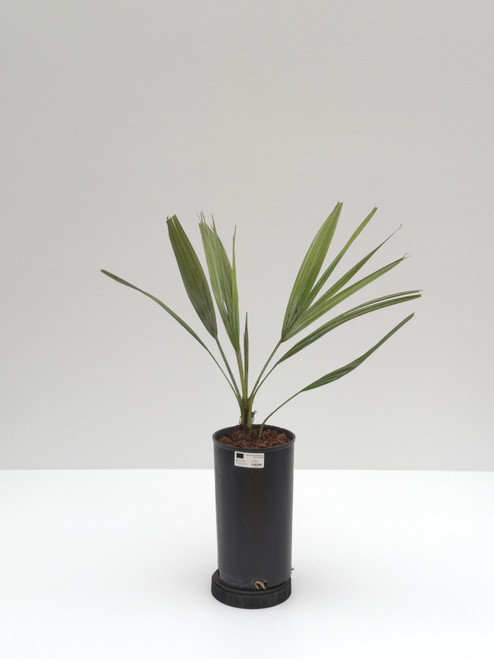Product Description
Habitat and Distribution
Brahea dulcis is found in Southern N. America - Reo Grande Valley of Texas, Northeastern Mexico and southwards to Guatemala, and Nicaragua, common on cliffs, and rough terrain. Dry woodlands, usually in limestone deposits.
Description
Usually single trunked, rarely clustering palm to about 7.5 m tall, costapalmate leaves, with both blue and green forms. Hight: to 25 feet (7.5 m). Leaf type: Costapalmate, 10 to 15 leaves per crown, slightly glaucous green. 30 to 50 leaflets, slightly armed. Trunk detail: Solitary, to 8 inches in diameter (12 to 20 cm). Flower: Monoecious. Flower spathe emerging from the crown, amongst the fronds, thick, tomentose. Fruit: green to brown, tomentose.. 0.4 to 0.6 inch long (1 to 1.5 cm). edible fruits, ovoid. Leaf type: Costapalmate, 10 to 15 leaves, slightly glaucous green. 30 to 50 leaflets, slightly armed petiole. Fruit: green to brown, tomentose.. 0.4 to 0.6 inch long (1 to 1.5 cm). edible fruits, ovoid. Height: to twenty feet. Trunk type: Solitary, and clustering, within the same species. Leaf detail: Palmately compound, bright green, finely cut, fronds smaller than other Brahea. Brahea var. berlandieri and B. var. bella are horticultural selections which have at times been assigned species status. Brahea dulcis distinguishing characteristic is in having uniformly green leaves in contrast to the silvery-glaucous foliage of Brahea berlandieri. However, as wild collected specimens at the Huntington Garden exhibit identical floral and structural characteristics, Brahea berlandieri var. bella can hardly be considered to be a separate species. In addition, there are mixed populations in Mexico with both "varieties" present. To add to the confusion, both have been considered to be varieties of the widespread Brahea dulcis by some authorities, and taxonomically still are. Editing by edric.
Culture
Requirements: Water sparingly, Min. Temperature: 23°F (-3°C), well drained position. Frost and drought tolerant. Dislikes high humidity. Slow growing. A very tough, drought and frost resistant, and easy to grow palm for temperate and subtropical climates.
Comments and Curiosities
Certainly the most confusing of the Braheas, the stems can be short or tall, thick or thin, solitary or suckering, and the leaves can range from green to glaucous blue. Coupled with this is its huge range, from N-Mexico right down to Guatemala, with many variations along the way. (RPS.com)























